
- Ecommerce Marketing
- Integration
- Partners
- Product
Supercharge Customer Engagement with Okendo & Klaviyo
Guest Author | Apr 21, 2025
Mar 7, 2023 | 14 minute read
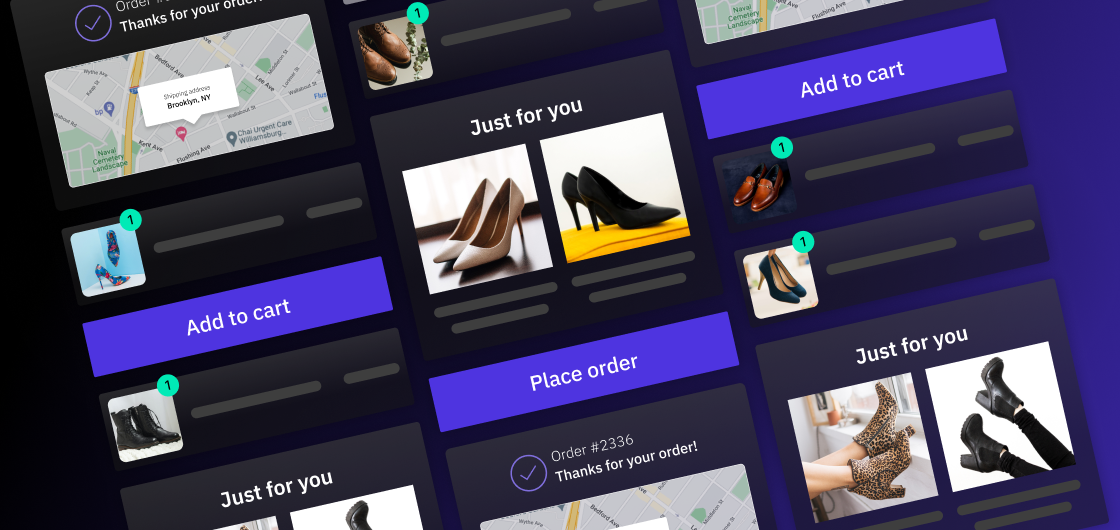
Matt Goodman
Co-founder, CEO
It’s never been more important for ecommerce brands to focus on conversion rate optimization. With customer acquisition costs spiraling amid broader economic challenges like inflation, rising interest rates, and high supply chain costs, the urgency for brands to maximize the value of their visitors and existing customers has been ratcheted up significantly.
In fact, recent research found that merchants today lose $29 every time they acquire a new customer – a statistic that represents a 222% rise in the last eight years. This means that they’re actually spending more money winning customers’ business than they’re getting in return.
This also suggests that consumers today are being much more conscientious about who they give their money to which is requiring marketing teams to spend more time and dollars winning them over. Furthermore, it showcases how brands are struggling mightily with rising marketing costs and lower returns on their investments.
But you don’t need to spend tens of thousands of dollars to entice more people to buy from your store. Rather, the biggest drivers of conversions are actually simple features that can be found on your website and throughout your customer journey. But don’t just take it from us.
We spoke to 14 ecommerce and marketing experts who shared their tips for improving conversion rates. In addition to shedding insight on what works for them, they’ve also highlighted some of the most common mistakes brands make which hurt their online shopping experience and cause website visitors to jump ship before placing an order.
Here’s 5 things our expert panel told us.
When it comes to optimizing your conversion rate, it’s crucial that you invest in site speed improvements. A slow-loading website can dramatically impact your user experience, leading to higher bounce rates and lower sales.
In fact, 70% of consumers say that page speed impacts their willingness to buy from an online retailer – a statistic that perfectly encapsulates just how crucial page speed is in this age where consumers already expect everything on demand.
As Katelyn Glass, Founder and CEO at FiftySix, says, “It sounds small, but fractions of seconds make all the difference when it comes to conversion rates. Consumers hate waiting (personally, I blame Amazon for this). But with evidence showing that conversion rates increase when site speed gets better, it’s important to do what you can.”
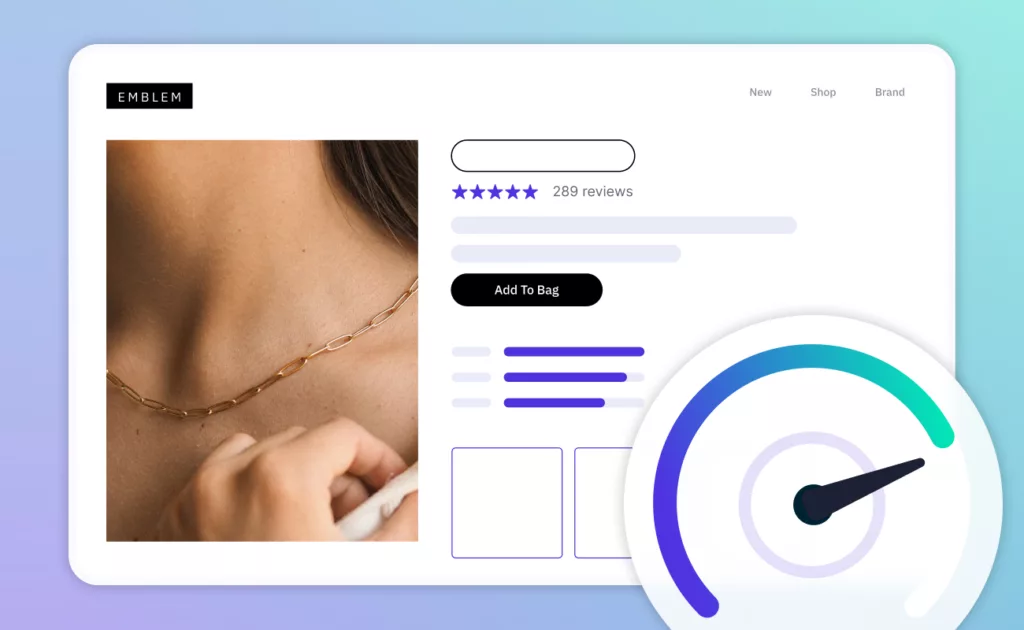
Jen Root, CRO at Alpha Omega Agency, agrees. She actually recommends checking and optimizing your site speed every two months for peak performance. Meanwhile, Varfaj CEO David Conforti includes it amongst the three “S’s” his brand has deemed critical for optimizing on-site conversions (the others being simplicity and social proof).
But what changes can you make to ensure fast site speeds?
Glass recommends reducing unnecessary code and compressing your images. At Okendo, we also believe that choosing the right applications – and minimizing bloatware (unnecessary applications and services) – is key. For example, it’s not uncommon for brands to add new features to their sites in an ad hoc fashion, often following current trends that highlight the “unmissable” benefits of a certain plugin. Over time, these extra functionalities add up, resulting in several seconds of additional load time in exchange for a small benefit that the average user may never notice.
Removing any apps, plugins, or scripts that are no longer in use frees up valuable resources and improves site performance, benefiting your users and your conversion rate.
Every ecommerce brand should strive to consistently deliver a personalized shopping experience. It’s a proven loyalty-builder, with consumers increasingly prioritizing doing business with brands that understand their unique needs and expectations.
Personalization is no longer just a desire. Today’s consumers expect it, as highlighted by recent data which shows that 62% of consumers say that a brand will lose their loyalty if their experience is not personalized.
Clearly, a “one-size-fits-all” approach no longer works if you want to increase your conversion rate. There are many ways that personalization can help you to do so, according to Ryan O’Connor, Director of Ecommerce Marketing at SmartBug Media. As well as improving the user experience and making your brand appear more relevant to your customers, personalization can have a huge impact on trust, engagement, and loyalty, he says.
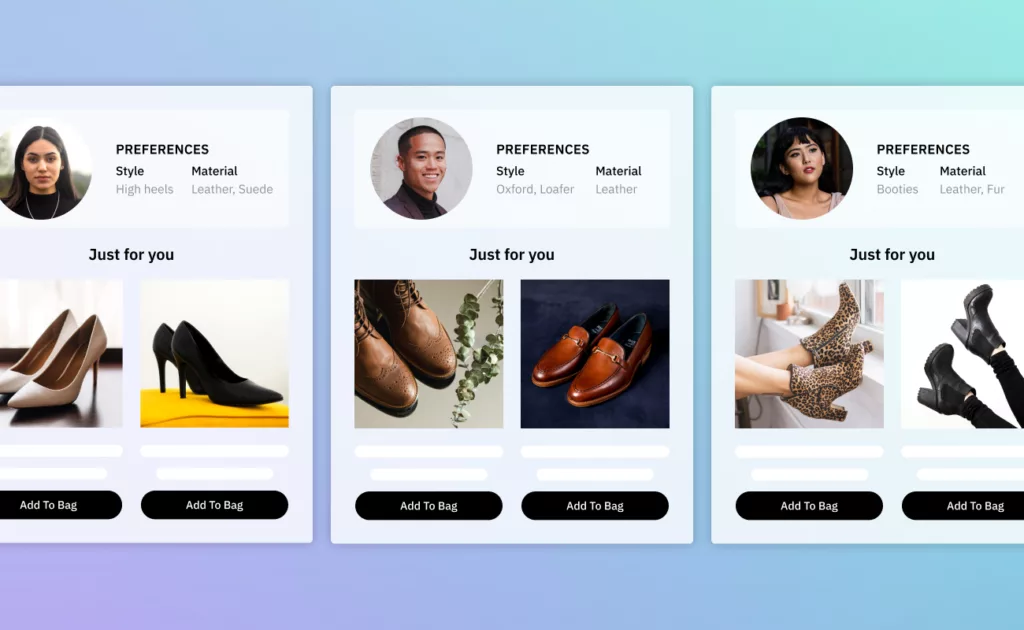
“Personalized content is more likely to engage users and keep them on your website longer, which increases the chances of them making a purchase,” Ryan says. “It can also help you to build trust between your brand and the customer, which can lead to higher conversion rates.”
These are sentiments that Alpha Omega Agency’s Jen Root agrees with. According to Root, “Personalization is key to enhancing the overall customer experience and improving on-site conversions. By providing a tailored, targeted experience, you are increasing the likelihood of first-time/impulse customer purchase by 50%”.
Now, that’s an improvement no brand wants to turn down. But how exactly do you personalize your customer experiences on your website or digital storefront?
Once customers are on your website, personalization in the form of a product recommendation quiz can go a long way in increasing conversions.
Rachel Tyers, SVP of Marketing & Partnerships at Okendo, says, “Customers want to feel a connection with your brand. According to 58% of consumers, offering a quiz to get to know their individual needs is a way brands can exceed their expectations. Quizzes also give brands the opportunity to create personalized experiences and build stronger connections with their customers. With a quiz, brands can quickly match shoppers to products that best fit the shoppers’ individual profiles. This personalized experience enables faster purchasing decisions that lead to increased conversions.”
Rise.ai’s Head of Partnerships, Roee Stimler, suggests incentivizing your customers with personalized, digital gift cards. For example, you can automatically reward your customers with a gift card for purchasing specific products, meeting certain spending thresholds, or even writing a review. This is a tactic that performs particularly well for Rise.ai’s customers, who enjoy a 24% increase in upsell value when they send their customers a gift card.
Nicole Booth, Partner Manager, Technology Partnerships at Klaviyo, recommends using on-site forms to subscribe more visitors and re-engage customers based on time spent on page, their number of visits, the devices they’re using, or their market segment. “Not all visitors should be receiving the same on-site experience”, she asserts.
But there’s one thing every marketing team needs in order to deliver truly personalized online customer experiences. Something that’s also your brand’s holy grail: data.
We’ve been preaching this for years. But it’s fair to say that amidst this unstoppable shift to a more privacy centric web, the value of data is skyrocketing.
For example, recent moves by Apple and Google to enhance and protect consumer privacy rights online mean brands are finding it much more difficult to uncover their buyers’ behavioral patterns. This, in turn, is making personalized ecommerce experiences harder to achieve, despite the fact that consumers are craving them more.
While second and third-party data is becoming more difficult to accurately capture, zero-party data is now a saving grace for marketing teams. Zero-party data is defined as data shared directly and proactively by consumers with permission to use it for future marketing purposes. This includes using it to tailor the online shopping experience to each individual consumer so that they feel more enticed to make a purchase.
As Klaviyo’s Nicole Booth describes, “Utilizing zero-party data to personalize the way you communicate with customers is key to maximizing repeat sales and order values. Owning consumer data, i.e. what makes them click, what makes them bounce, and what makes them buy, empowers brands to get personal-turning transactions into long-term productive relationships.”
She adds that this type of data enables brands to ditch what she calls “batch and blast” marketing, and instead target shoppers based on their geographical locations, how much money they typically spend, and which products they like the most.
But how are brands today gathering these types of customer insights? The answer is in-moment surveys.
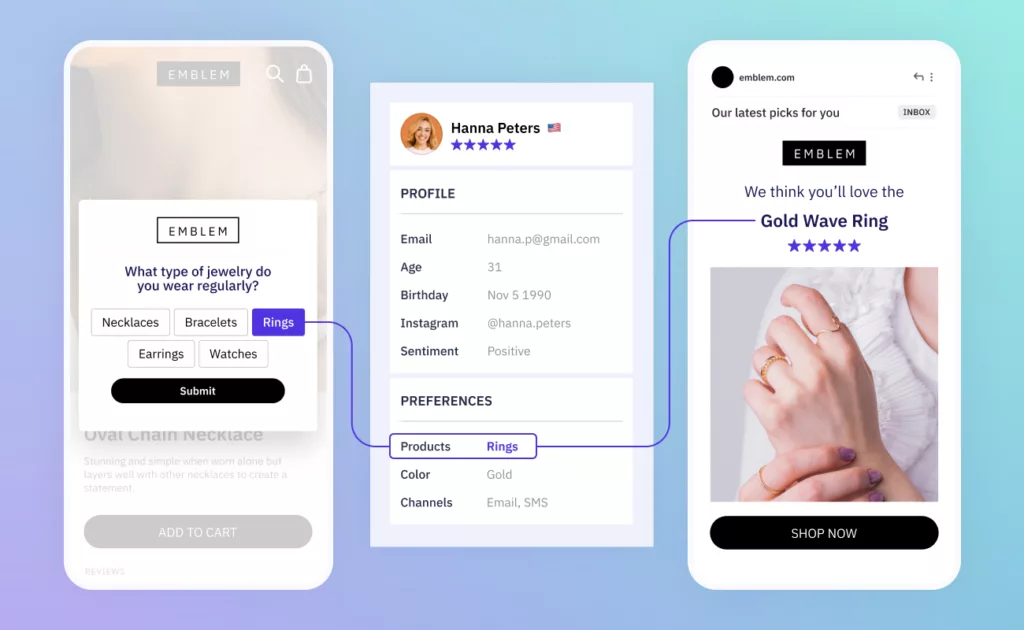
Indeed, in-moment surveys have become a secret weapon for marketers looking to engage website visitors and customers at peak moments of engagement. On-site surveys, for example, are precisely targeted and hyper-relevant surveys that generate continuous streams of actionable customer insights. This allows you to deliver highly personalized shopping experiences through your website or online storefront, and as a result, grow your conversion rate.
Rick Eliason, Global Head of SEO at Reload Digital, describes how one of his customers – a pet supplement brand – used surveys to understand their customers better.
“We know through surveys and persona development that some potential customers are price conscious whereas with others, money is no object when it comes to the welfare of their beloved pet,” he says. Armed with this information, his team was able to split-test metadata across a variety of journey entry points to uncover which types of marketing messaging worked best on which customers.
He adds: “Winning this first moment is crucial to conversion but its secondary benefit is that we’ve already primed the customer – they are more likely to absorb additional information pertaining to their implicit requirements and their finger will be practically hovering over the buy button!”
Alon Abraham, Co-founder at TAG also highlighted the importance of first-party data for boosting sales. “The number one tip for improving on-site conversion is to continually test and optimize your website based on data and user behavior,” he says. “This means regularly analyzing your website analytics, conducting user testing and surveys, and making data-driven decisions about what changes to make to your website.”
With consumers today faced with an overwhelming number of shopping options, social proof is needed to cut through the noise and help them make more informed and confident purchases. Two of the most effective ways for brands to provide their customers with this social proof is through reviews and user generated content (UGC).
As Daria Rose, VP, Product at TVP NYC says, “In a world where people can’t hold your product, they need to know what other people thought of it. Don’t think twice about this. Use reviews.”
Varfaj’s David Conforti agrees. “There is a lot of data supporting reviews and UGC as two of the top drivers of conversions online. When you are shopping online you can’t physically see or touch the product you are buying so the best gauge of the quality of a product is from others that have used it themselves.”
When you consider the fact that 95% of consumers say they believe reviews are important when making a purchase decision, with a significant portion (34%) asserting that they are “extremely” important, Rose’s and Varfaj’s views are unsurprising. In fact, a vast majority of our experts label reviews – and specifically high-quality reviews that display UGC – as essential for improving your conversion rate.
You see, it’s not just your quantity of reviews that matter. It’s their quality, too. And the more reviews you have that showcase descriptive, rich content, include a star rating, and feature product or customer attributes, the more likely you are to convert more shoppers.
Why? “People want to know what others think, what the product looks like, what the customer service was like etc., before committing to a purchase from you,” says Dulcie Hanham-Gross, Associate Director of DTC Strategy at The Stable.
Meanwhile, ShopTrade’s CEO and Founder, Mohammadu Mifras, describes these types of high-quality reviews as especially “powerful” for attracting our younger and most influential customers. “Millennials trust user-generated content 50% more than other media. It takes trust to achieve conversion, making a direct link between reviews, UGC and conversion.”
When you go through the hard work to collect these reviews, however, it’s imperative that you maximize their value. One way to do this is to use Okendo’s highly customizable reviews widgets, which capture and hold customer attention on your website’s most engaged pages, like the product details pages.
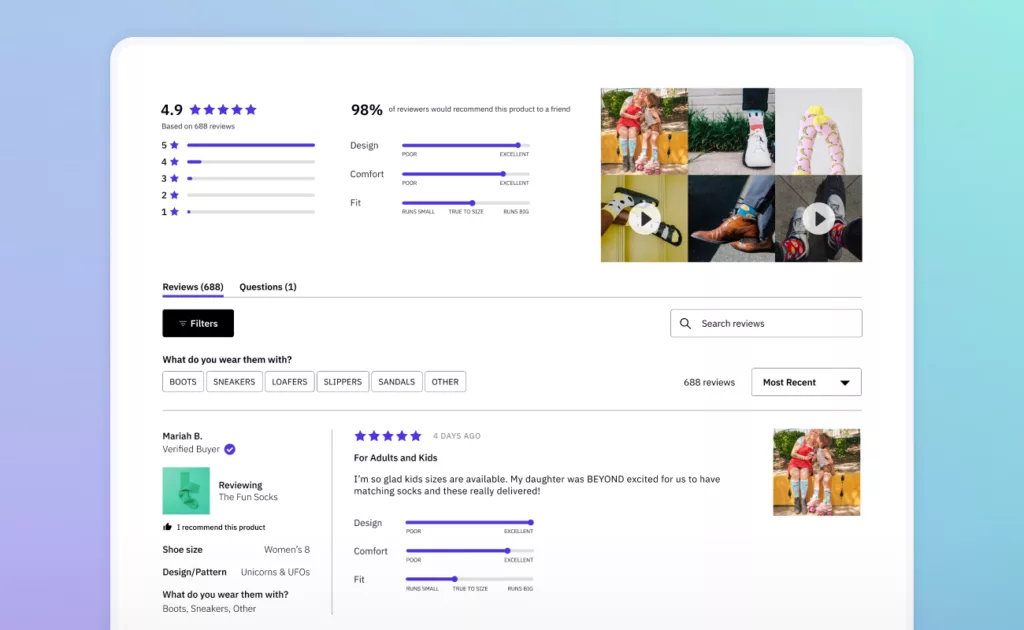
FiftySix’s Katelyn Glass also recommends highlighting your best reviews, including some of your most on-brand pieces of UGC, at other locations like your homepage. This makes it extremely easy for visitors to envision what your product looks like when it’s in use, while reading real-time feedback. She says, “Think of it like staging a house. Realtors decorate houses so they sell faster. That’s just like on-site reviews and UGC for a website.”
Every feature that our experts have outlined so far are proven contributors to high conversion rates. But the truth is, when you pair these elements together with other factors that hurt the user experience, you’re putting your investments to waste. And according to our experts, there are several site features that damage brands’ conversion rates – many of which they don’t even realize.
Here’s what our experts pinpointed as the three biggest factors hurting your conversion rate.
We know that simple website designs have a positive impact on conversions. Yet, many brands fall into a trap where they feel like they need to make changes just for the sake of it. This creates an unfamiliar user interface (UI) according to Matthew Fier, VP of Retention Marketing at QDL Agency, which just frustrates visitors and causes them to bounce.
“We know what cart icons look like,” he says. “We know how to navigate site after site. Why change that for the sake of looking ‘cooler’? Remember, we have a finite amount of time for each consumer on site.”
TVP NYC’s Daria Rose agrees. “While it can be tempting to develop something ‘cool’, more often than not, the cost to execute and maintain will be too high resulting in buggy websites. Nothing removes trust like a buggy website!”
Instead, The Stable’s Dulcie Hanham-Gross recommends being concise and direct with information. “Give your customers information that’s easy to digest, to the point and use your brand voice in doing so. Don’t go overboard – nobody reads anymore!”
According to our research, 95% of consumers say that trust is a factor in deciding what brands to do business with, with 55% saying it is a “significant” factor. Misleading your customers, or hiding important information, will cause customers to perceive your brand as untrustworthy and inauthentic.
One mistake brands make which contributes to this, according to SeaMonster Studios’ CEO Wes Buckwalter, is only showcasing your positive reviews. He says, “Everyone gets a negative review now and again. It’s not only essential to respond to the review and make the negative into a satisfying positive for the end user, but it’s also important to show your prospective customers the negative review and your candid response to the customer who left. This shows your willingness to delight your customer in a bad situation. Respond to your customer, fix the problem, and make sure your other customers know that you’ve done it.”
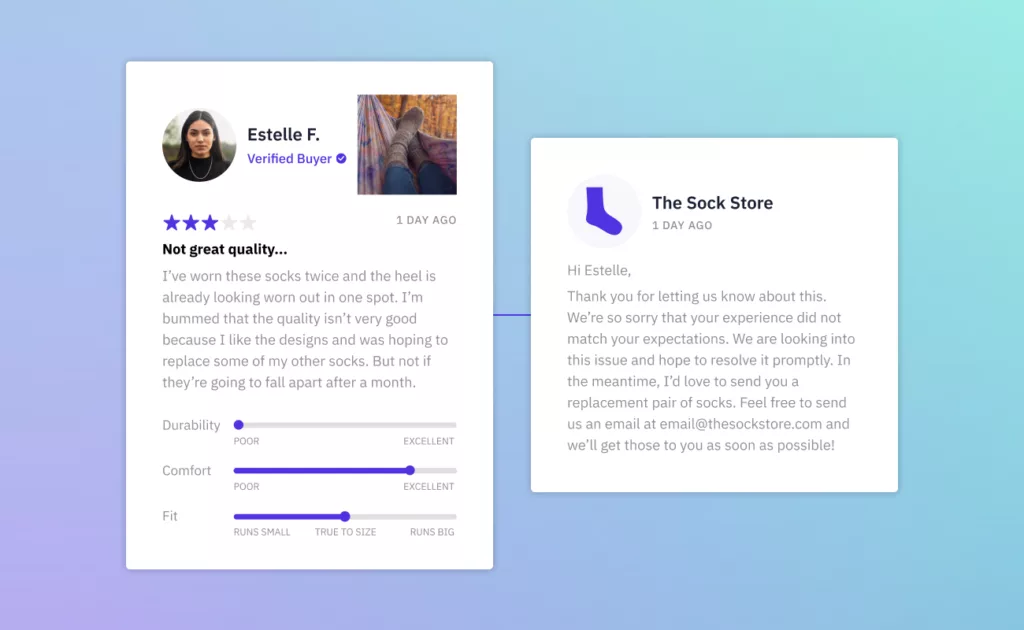
Meanwhile, Bri Christiano, Director of Customer Support at Gorgias, says that many brands are struggling to garner trust and convert sales because they’re not being fully transparent at the certain stages of the customer journey.
“The number one cause of cart abandonment is surprise fees hidden at the end of the checkout process,” she asserts. “Requiring too much information and a lack of payment options are close behind. Implement checkout progress trackers, integrate one-click payment options, and offer free (or qualified free) shipping to get shoppers over the finish line.”
With mobile commerce volume expected to hit $620.97 billion by 2024, it’s clear that every ecommerce website must be optimized for mobile.
Yet, TAG Co-founder, Alon Abraham, says that he often sees a lack of mobile optimization causing a poor smartphone and tablet experience on brand’s digital storefronts.
“As more and more users access the internet on their phones, it’s crucial to make sure that your website is easily readable and usable on mobile devices,” he states. “This may involve creating a responsive design or a separate mobile version of your site.”
QDL’s Matthew Fier agrees. He recommends that brands “keep it simple and think mobile first.”
He says, “Industry-wide (per Shopify), we are seeing higher rates with abandoned checkout on mobile vs. desktop. A site might look near-perfect on desktop, but if it can’t render on every mobile screen in the world, you will lose the majority of your sales opportunities.”
Did you love this blog and want to learn more about how you can improve your ecommerce conversion rate? Book a demo, or visit the Okendo Surveys product page to learn more about how we can help you optimize your online shopping experience and boost sales.
Related articles
Ready to learn more?